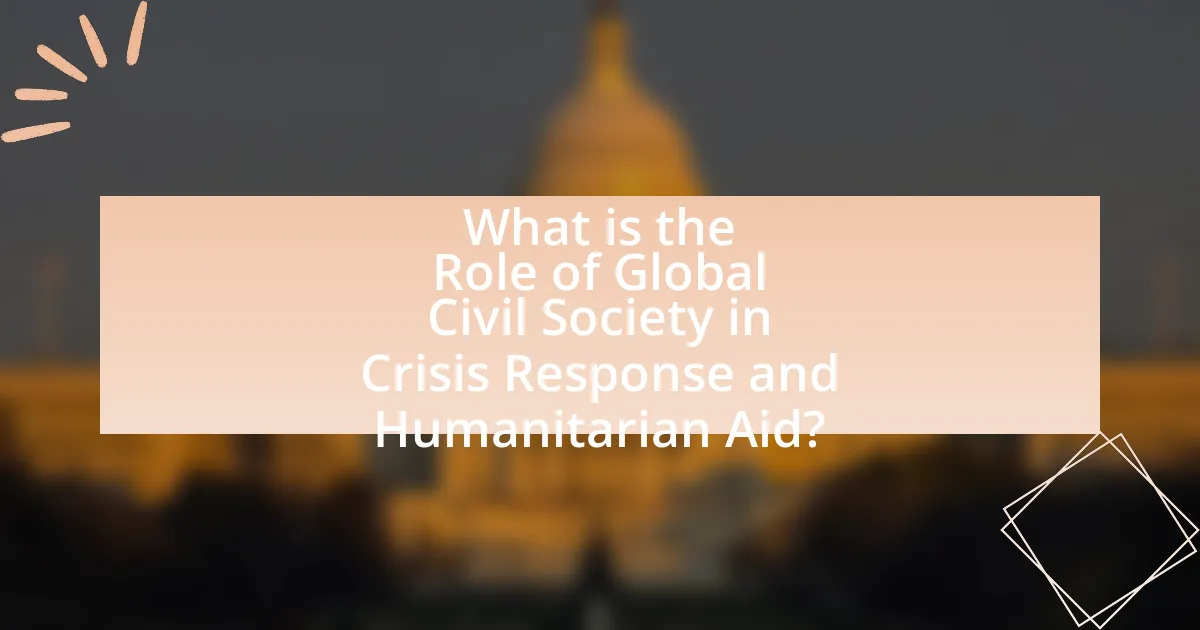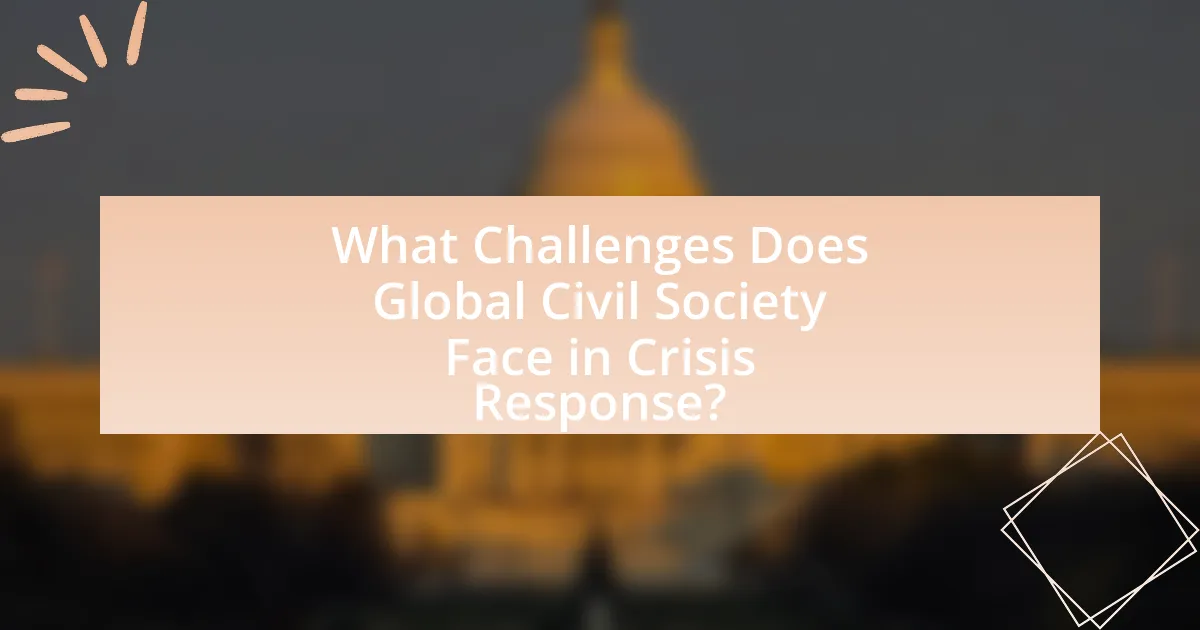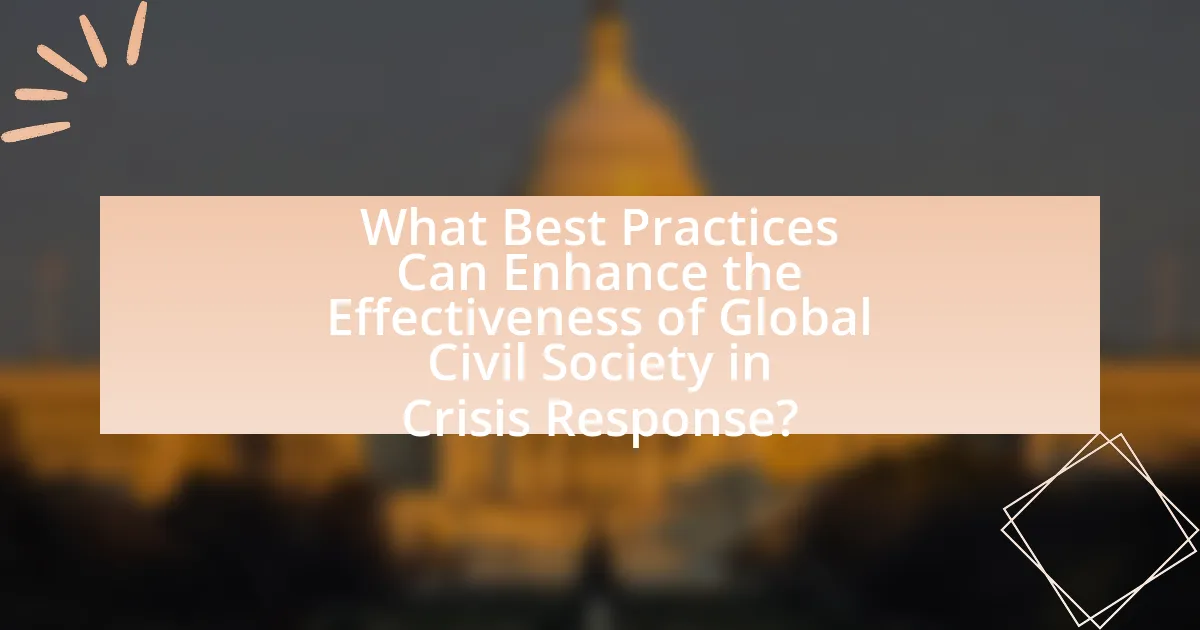Global civil society, encompassing organizations such as non-governmental organizations (NGOs) and community groups, plays a vital role in crisis response and humanitarian aid by mobilizing resources, delivering immediate assistance, and advocating for affected populations. The article examines how these organizations contribute to effective crisis management, highlighting their ability to coordinate efforts, enhance local capacities, and address challenges such as resource limitations and political constraints. Key organizations involved in global civil society, their collaborative strategies, and best practices for improving humanitarian initiatives are also discussed, emphasizing the importance of community engagement and technology in enhancing response efforts.

What is the Role of Global Civil Society in Crisis Response and Humanitarian Aid?
Global civil society plays a crucial role in crisis response and humanitarian aid by mobilizing resources, providing immediate assistance, and advocating for affected populations. Organizations within global civil society, such as non-governmental organizations (NGOs) and community groups, often operate on the ground during crises, delivering food, medical care, and shelter to those in need. For instance, during the 2010 Haiti earthquake, NGOs like Partners In Health and the Red Cross were instrumental in providing emergency medical services and rebuilding efforts, demonstrating the effectiveness of civil society in crisis situations. Furthermore, global civil society advocates for policy changes and raises awareness about humanitarian issues, influencing governmental and international responses to crises. This advocacy is supported by data showing that countries with active civil societies tend to have more effective disaster response mechanisms, as highlighted in the World Bank’s report on civil society’s impact on development outcomes.
How does Global Civil Society contribute to crisis response efforts?
Global Civil Society contributes to crisis response efforts by mobilizing resources, providing immediate assistance, and advocating for affected populations. Organizations within Global Civil Society, such as NGOs and grassroots movements, often have established networks that enable rapid deployment of aid, including food, medical supplies, and shelter, during emergencies. For instance, during the 2010 Haiti earthquake, NGOs like Partners In Health played a crucial role in delivering healthcare and rebuilding infrastructure, demonstrating the effectiveness of civil society in crisis situations. Additionally, Global Civil Society raises awareness and advocates for policy changes to address the root causes of crises, influencing governmental and international responses. This multifaceted approach enhances the overall effectiveness of humanitarian aid and crisis management.
What are the key organizations involved in Global Civil Society?
Key organizations involved in Global Civil Society include Amnesty International, Oxfam, Human Rights Watch, and the International Federation of Red Cross and Red Crescent Societies. These organizations play significant roles in advocating for human rights, providing humanitarian aid, and responding to crises globally. For instance, Amnesty International focuses on human rights advocacy, while Oxfam addresses poverty and social injustice through emergency response and development programs. Human Rights Watch conducts research and advocacy on human rights violations, and the International Federation of Red Cross and Red Crescent Societies coordinates humanitarian efforts during emergencies, demonstrating the diverse functions these organizations serve in global civil society.
How do these organizations coordinate their efforts during crises?
Organizations coordinate their efforts during crises through established networks, communication protocols, and collaborative frameworks. These entities often utilize platforms like the Inter-Agency Standing Committee (IASC) to facilitate coordination among various humanitarian actors, ensuring that resources are allocated efficiently and responses are synchronized. For instance, during the 2010 Haiti earthquake, organizations such as the United Nations and non-governmental organizations worked together to streamline aid distribution, share information, and avoid duplication of efforts, demonstrating the effectiveness of coordinated action in crisis situations.
Why is Global Civil Society important in humanitarian aid?
Global Civil Society is important in humanitarian aid because it enhances the effectiveness and reach of aid efforts. Organizations within Global Civil Society, such as non-governmental organizations (NGOs) and community groups, often have local knowledge and networks that enable them to respond quickly and effectively to crises. For instance, during the 2010 Haiti earthquake, local NGOs played a crucial role in delivering immediate assistance and mobilizing resources, demonstrating their capacity to operate in challenging environments. Furthermore, Global Civil Society advocates for marginalized populations, ensuring that their voices are heard in humanitarian decision-making processes, which leads to more equitable and inclusive aid distribution.
What unique advantages does Global Civil Society offer in humanitarian contexts?
Global Civil Society offers unique advantages in humanitarian contexts, including enhanced local engagement, rapid response capabilities, and diverse resource mobilization. These organizations often have established networks within affected communities, allowing them to understand local needs and cultural sensitivities better than larger international entities. For instance, during the 2010 Haiti earthquake, local NGOs were crucial in delivering immediate aid and rebuilding efforts, demonstrating their ability to mobilize quickly and effectively. Furthermore, Global Civil Society can leverage a wide range of resources, including volunteer networks and grassroots fundraising, which can complement governmental and intergovernmental efforts in crisis situations. This multifaceted approach enhances the overall effectiveness of humanitarian response initiatives.
How does Global Civil Society enhance local capacities in crisis situations?
Global Civil Society enhances local capacities in crisis situations by providing resources, expertise, and advocacy that empower local communities to respond effectively. Organizations within Global Civil Society, such as NGOs and international coalitions, often mobilize funding, technical assistance, and training programs tailored to the specific needs of affected populations. For instance, during the 2010 Haiti earthquake, various global NGOs collaborated with local groups to deliver immediate relief while also building long-term resilience through capacity-building initiatives. This collaboration not only addressed immediate needs but also strengthened local governance and community organization, demonstrating the effectiveness of Global Civil Society in enhancing local capacities during crises.

What Challenges Does Global Civil Society Face in Crisis Response?
Global civil society faces significant challenges in crisis response, including resource limitations, coordination difficulties, and political constraints. Resource limitations hinder the ability of organizations to mobilize quickly and effectively, as many rely on donations and funding that may be inconsistent during crises. Coordination difficulties arise from the multitude of actors involved, leading to fragmented efforts and inefficiencies in delivering aid. Political constraints often restrict access to affected areas or complicate partnerships with local governments, impacting the overall effectiveness of humanitarian initiatives. These challenges are evidenced by reports from organizations like the United Nations, which highlight the need for improved collaboration and resource allocation in crisis situations.
What are the main obstacles to effective crisis response by Global Civil Society?
The main obstacles to effective crisis response by Global Civil Society include limited resources, lack of coordination, and political constraints. Limited resources hinder organizations from mobilizing adequate support and personnel during crises, as many rely on donations and grants that may not be sufficient. Lack of coordination among various civil society organizations can lead to duplicated efforts and inefficiencies, as seen in the aftermath of the 2010 Haiti earthquake, where multiple NGOs operated independently without a unified strategy. Political constraints, such as government restrictions on foreign aid and civil society activities, can further impede the ability of these organizations to operate effectively in crisis situations, exemplified by the challenges faced by NGOs in countries with authoritarian regimes.
How do funding limitations impact the effectiveness of Global Civil Society?
Funding limitations significantly reduce the effectiveness of Global Civil Society by constraining resources necessary for operational activities. When organizations face financial shortfalls, they struggle to implement programs, conduct outreach, and mobilize volunteers, which are essential for effective crisis response and humanitarian aid. For instance, a report by the Global Humanitarian Assistance in 2021 indicated that funding for humanitarian efforts fell short by approximately $10 billion, leading to reduced aid delivery in critical regions. This lack of funding directly impacts the ability of civil society organizations to respond promptly and adequately to crises, ultimately diminishing their role in providing essential services and support to affected populations.
What role does political context play in the operations of Global Civil Society?
Political context significantly influences the operations of Global Civil Society by shaping the environment in which these organizations function. Political factors such as government policies, legal frameworks, and the level of political freedom directly affect the ability of civil society organizations to mobilize resources, advocate for change, and engage with communities. For instance, in authoritarian regimes, restrictions on freedom of assembly and expression can severely limit the effectiveness of civil society in delivering humanitarian aid or responding to crises, as seen in countries like Syria and Venezuela, where political repression has hindered aid efforts. Conversely, in democratic contexts, supportive political environments can enhance the capacity of Global Civil Society to operate effectively, as evidenced by the robust response of civil society organizations during the Ebola outbreak in West Africa, where collaboration with governments facilitated rapid mobilization of resources and support.
How can Global Civil Society overcome these challenges?
Global Civil Society can overcome challenges in crisis response and humanitarian aid by enhancing collaboration among diverse stakeholders, including NGOs, governments, and local communities. This collaborative approach allows for the pooling of resources, knowledge, and expertise, which is essential for effective crisis management. For instance, the Sphere Standards, developed by humanitarian organizations, emphasize the importance of coordination and shared best practices to improve aid delivery. Additionally, leveraging technology for real-time data sharing and communication can significantly improve response times and resource allocation, as evidenced by the use of mobile applications in disaster response scenarios. By fostering partnerships and utilizing innovative solutions, Global Civil Society can effectively address the complexities of humanitarian crises.
What strategies have proven effective in enhancing the resilience of Global Civil Society?
Strategies that have proven effective in enhancing the resilience of Global Civil Society include fostering collaboration among diverse stakeholders, leveraging technology for communication and mobilization, and building local capacities through training and resources. Collaborative efforts, such as partnerships between NGOs, governments, and community organizations, enable resource sharing and knowledge exchange, which strengthens collective action during crises. The use of technology, including social media and digital platforms, facilitates rapid information dissemination and mobilizes support, as seen during the COVID-19 pandemic when civil society organizations effectively coordinated responses online. Additionally, investing in local capacity-building initiatives empowers communities to respond to their unique challenges, evidenced by programs that train local leaders in crisis management and advocacy, thereby enhancing overall resilience.
How can partnerships improve the impact of Global Civil Society in crises?
Partnerships can significantly enhance the impact of Global Civil Society in crises by facilitating resource sharing, improving coordination, and leveraging diverse expertise. For instance, collaborations between local NGOs and international organizations can lead to more effective responses, as seen during the 2010 Haiti earthquake, where partnerships enabled rapid mobilization of aid and resources. Additionally, joint efforts can amplify advocacy for vulnerable populations, as demonstrated by coalitions that successfully influenced policy changes during humanitarian emergencies. These partnerships not only increase operational efficiency but also foster trust and community engagement, which are crucial for sustainable crisis response.

What Best Practices Can Enhance the Effectiveness of Global Civil Society in Crisis Response?
Best practices that can enhance the effectiveness of global civil society in crisis response include fostering collaboration among diverse stakeholders, utilizing data-driven decision-making, and ensuring community engagement. Collaboration among NGOs, governments, and local organizations leads to resource sharing and coordinated efforts, which have been shown to improve response times and outcomes in crises, as evidenced by the successful partnerships during the 2010 Haiti earthquake. Data-driven decision-making allows organizations to assess needs accurately and allocate resources efficiently, as demonstrated by the use of real-time data analytics in the response to the COVID-19 pandemic. Community engagement ensures that responses are culturally appropriate and meet the actual needs of affected populations, which has been highlighted in studies showing that local involvement increases the sustainability of humanitarian efforts.
What are the key best practices for Global Civil Society in humanitarian aid?
Key best practices for Global Civil Society in humanitarian aid include fostering local partnerships, ensuring transparency and accountability, and prioritizing community involvement. Fostering local partnerships enhances the effectiveness of aid by leveraging local knowledge and resources, which has been shown to improve response times and outcomes in crises. Transparency and accountability build trust with affected communities and donors, as evidenced by organizations that adhere to the Sphere Standards, which emphasize ethical practices in humanitarian response. Prioritizing community involvement ensures that aid efforts are aligned with the actual needs of the population, leading to more sustainable and impactful interventions, as highlighted in the Humanitarian Accountability Partnership’s guidelines.
How can effective communication improve crisis response efforts?
Effective communication enhances crisis response efforts by ensuring timely and accurate information dissemination among stakeholders. When organizations share clear and concise updates, it facilitates coordinated actions, reduces misinformation, and builds trust within affected communities. For instance, during the 2010 Haiti earthquake, effective communication strategies employed by NGOs and international agencies allowed for rapid mobilization of resources and assistance, significantly improving the overall response effectiveness. This demonstrates that structured communication channels can lead to better resource allocation and quicker recovery outcomes in crisis situations.
What role does community engagement play in successful humanitarian initiatives?
Community engagement is crucial for the success of humanitarian initiatives as it fosters trust, enhances local knowledge, and ensures that interventions are culturally appropriate. Engaging communities allows humanitarian organizations to understand the specific needs and priorities of the affected populations, leading to more effective and sustainable solutions. For instance, a study by the Overseas Development Institute found that projects involving community participation are 30% more likely to succeed compared to those that do not involve local stakeholders. This evidence highlights that when communities are actively involved in the planning and implementation of humanitarian efforts, the initiatives are more likely to be accepted and supported, ultimately leading to better outcomes.
How can Global Civil Society leverage technology for better crisis response?
Global Civil Society can leverage technology for better crisis response by utilizing data analytics, communication platforms, and social media to enhance coordination and information dissemination. For instance, organizations can use real-time data analytics to assess needs and allocate resources effectively during emergencies, as demonstrated by the use of platforms like Ushahidi, which aggregates crisis information from various sources. Additionally, communication tools such as WhatsApp and Twitter facilitate rapid information sharing among stakeholders, enabling quicker responses. A study by the United Nations Office for the Coordination of Humanitarian Affairs highlights that effective use of technology can improve response times by up to 30%, showcasing its critical role in enhancing crisis management efforts.
What technological tools are most beneficial for Global Civil Society?
The technological tools most beneficial for Global Civil Society include social media platforms, mobile communication apps, data analytics software, and online fundraising platforms. Social media platforms like Twitter and Facebook enable rapid information dissemination and mobilization of support during crises, as evidenced by their use in the Arab Spring and various humanitarian campaigns. Mobile communication apps, such as WhatsApp and Signal, facilitate real-time communication among activists and organizations, enhancing coordination and response efforts. Data analytics software allows civil society organizations to analyze large datasets for better decision-making and resource allocation, demonstrated by the use of data in tracking disease outbreaks. Online fundraising platforms, like GoFundMe and Kickstarter, provide essential financial support for initiatives, enabling grassroots movements to gather resources quickly and effectively.
How can data analytics improve decision-making in crisis situations?
Data analytics can significantly improve decision-making in crisis situations by providing real-time insights and predictive modeling. By analyzing large datasets, organizations can identify patterns and trends that inform resource allocation, risk assessment, and response strategies. For instance, during the COVID-19 pandemic, data analytics enabled health authorities to track infection rates and optimize healthcare responses, leading to more effective containment measures. Furthermore, a study by the World Health Organization highlighted that data-driven decision-making can reduce response times by up to 30%, demonstrating the tangible benefits of utilizing analytics in crisis management.
What practical steps can organizations take to enhance their crisis response capabilities?
Organizations can enhance their crisis response capabilities by implementing comprehensive training programs for staff, establishing clear communication protocols, and conducting regular simulations of crisis scenarios. Training programs equip employees with the necessary skills and knowledge to respond effectively during emergencies, while clear communication protocols ensure that information flows efficiently among team members and stakeholders. Regular simulations, such as tabletop exercises, allow organizations to test their response plans and identify areas for improvement, thereby increasing overall preparedness. According to a study by the International Federation of Red Cross and Red Crescent Societies, organizations that engage in regular training and simulations are 30% more effective in their crisis response efforts compared to those that do not.